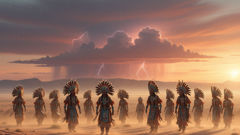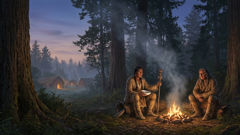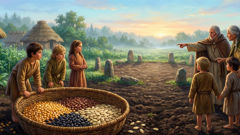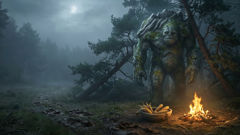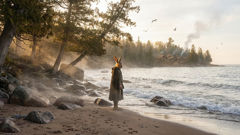Introduction
Wind travels fast across the Sahara, but rumors travel faster. In the salt-cracked sands of the Maghreb, where caravans weave like threads through a loom, a name begins to circle the encampments: Dihya, Kahina, the Prophetess of the Berbers. She was not born to rule a throne of gold, but to claim a destiny spoken in dreams and star maps. Her village slept under apricot skies when the first omens came—omens not of doom, but of a challenge that would require cunning, mercy, and a willingness to bear the burden of leadership. The earth remembers those who must stand between a people and their future, and the earth remembers Dihya because she listened to the whispering voices of ancestors in the dunes, and because she answered with a plan. The legends say she learned from elders who kept the old laws, and from women who stitched strength into the cloth of daily life. She grew up watching traders haggle in the shade of palm groves, learning to read weather as if it were a language, to read maps of stars as if they were signposts to safety. When the sea of sand rose and the northern empire pressed in with new soldiers and strange banners, she did not retreat. She gathered warriors from the hills, summoned marabout healers, and spoke to the young and old with a voice that was both iron and water—steady, clarifying, and, when needed, merciful. This is the story of a queen who was not born with a crown, but earned it with vision, courage, and a vow to shield her people from the encroaching storm. The tale blends history and folklore, a map drawn in the same breath as legends, where every caravan stop, every oasis, and every whispered prophecy becomes a thread in the larger fabric of a people’s memory. It is a story of resistance and identity, of keeping faith with a homeland that straddles the edge of both the desert and the sea of change, and of a queen who could foresee not only the battles ahead but the ways a culture might endure long after arrows fall silent.
Rising from the Sand: Dihya's Birth and the Making of a Prophetess
The stories begin in a place where the earth still remembers the footsteps of caravans that crossed centuries like rivers. Dihya’s birth is spoken of in hushed tones, as if the very wind cared enough to announce her coming with a dry whisper through the date palms. Some tell of a night when stars poured down in a silver rhyme, and a mother who hummed an old rite to shelter her child from listening ears that would mistake a dream for a threat. From childhood, she learned to move with a silence that startled predators and a curiosity that drew maps of the sky on the backs of leather skins. The elders watched the girl with eyes that measured time not in clocks but in harvests, storms and seasons. They taught restraint and courage in equal measure, how to weigh a choice with the patience of a river, how to choose mercy when the blade trembles, how to hold a line without losing the ground beneath it. In the shade of a single palm, she listened to the elders speak of a land that belonged to no single empire, a land that held both the memory of the clever hunter and the patient farmer. She learned to name the wind and to translate it into warnings and promises. It was in these lessons that she learned her first prophecy: the future would bend toward a reckoning, but a reckoning could be steered by a steady and fearless heart. The desert, she learned, does not surrender; it negotiates, it tests, it renews its shapes like a living sculpture. When the first foreign banners brushed the edges of memory and the old loyalties began to falter, Dihya didn’t wait for someone else to decide the fate of her people. She stepped into the circle, not with a coronet, but with a plan—one that would weave strategy with faith, and leadership with a tenderness that forbade despair. In the long nights that followed, she looked at the stars as if they were a council of ancestors, and she spoke aloud the promises she would keep: protection for the weak, justice for the betrayed, and a future that wouldn’t be sold to the highest bidder. The seed of leadership took root in a land that loved its storms as much as its oases, and it grew in a way that surprised even those who believed in legends. This is where the story begins, not with a contest of swords, but with a quiet decision to listen, learn, and rise when the moment demanded it. The people who would come to know Dihya would later speak of a spark in her eye, the way she could see a path through a maze of dust and doubt, and a voice that could turn fear into resolve. In that upbringing lies the cradle of a queen, a seer, and a beacon for those who would choose to resist. And so the legend begins in a circle of elders, beneath the open sky, with a girl who would become the leader her people needed, not the one they expected.
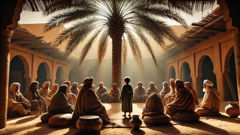
The Shield That Reads the Sky: Prophecy, Diplomacy, and the First Mobilization
The second strand of her early years is woven from two threads that rarely appear together: the exacting discipline of warfare and the patient art of alliance-building. Dihya learned that a queen’s strength isn’t merely the heft of spears or the ring of a shield, but the ability to hear the grievances of rival clans and to translate fear into a shared purpose. She spent nights with men who carried the weight of march routes, with women who tended the wounded and kept the camp fed when drought stretched its fingers toward the embers of the fires. In her conversations with the desert’s poets and healers, she learned to listen for the kind of truth that wounds before it heals, to honor the sacrifices of those who would never wear a crown but would lay down their lives for a village, for a child, for a memory of a homeland they might never see again. The old stories spoke of a pact between heaven and earth, a pact that could be read in the way the sand shifts when a caravan crosses a dune or in the way a newborn fox pauses at the edge of a campfire. Dihya began to map a future where defense and diplomacy moved in lockstep—where a skirmish could be a turning point, and a treaty could be the seed of a wider resilience. When a wandering tribe with a thirst for conquest arrived with steel and sermon, she didn’t rush to the sword alone. She invited the elders to negotiate in the shadow of the wells, she sent word to the other clans with a signal fire, and she staged a demonstration of unity, not merely of force. The show of strength was not only the clash of weapons, but the demonstration that a people united behind a single voice could turn fear into a shared strategy. In those meetings, she spoke not as a daughter of a single clan but as a guardian of a tapestry—threads of memory and law, of kinship and obligation—stitching together a resistance that would endure when banners fell apart. The prophecy she carried did not demand a single grand gesture; it demanded endless patient courage, a willingness to sacrifice ease for the sake of a future that would require more than prowess in battle. And so, with the desert wind as companion and the quiet assent of a people learning to believe in their own strength again, she began to mobilize into the first form of organized resistance, a chorus of tribes learning to stand shoulder to shoulder against a tide that sought to redraw their sky.
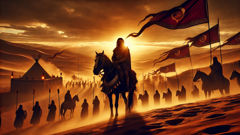
Conclusion
The desert keeps the memory of those who stood up to be counted, and the memory of Dihya endures in the stories that reappear in the mouths of travelers and elders alike. Her legend is not merely a chronicle of battles won or lost, but a testament to a way of seeing a future and choosing to shape it with both mind and heart. If you listen closely, you can hear the clink of armor that armor never quite loses its clang, the soft whisper of prophecy that never finishes its sentence, and the patient rustle of dunes rearranging themselves into a new map. The Kahina teaches that resilience is not a single, dramatic act, but a repeated act of faith—of standing in the same place when the world shifts, of guiding others toward a safer road, of letting a culture remember its own worth even when empire presses in. And so the legend travels on, across caravans and classrooms and centuries, carried in the breath of those who know that the fiercest battles are often fought in the quiet spaces between dawn and ruin. A queen who could read the stars, who could bend the wind with a name, who could turn fear into resolve—this is the memory we choose to keep. May her story remind us that courage arrives not with fanfare but with a stubborn, generous, enduring resolve to protect what matters most: a homeland people are willing to defend, not just today but for tomorrow.






